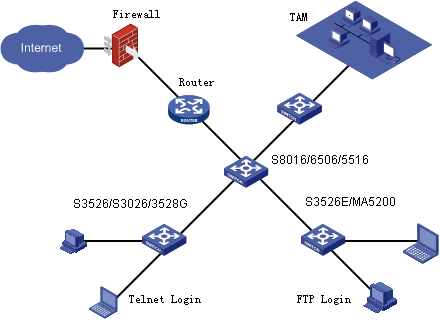Introduction
TAM provides authentication, authorization, and auditing for device maintainers, which are known as device users. It can assign device users different privileges, and monitor the login and command execution operations of device users in a large-scaled network, simplifying user privilege assignment and user management. By cooperating with other components in INC, TAM can implement integrated user, resource, and service management.
TAM supports the following services:
- Multiple device categorizing methods: Devices can be categorized based on management domain or device type in a hierarchical structure, facilitating user privilege assignment.
- Flexible, user-defined authorization policies: Multiple rules can be defined for each authorization policy. Each rule can assign device users different Shell Profiles and command sets based on authorization scenarios such as device area, device type, and authorized time range.
- User group management: You can assign users, of the same type, to one user group, simplifying user management. TAM supports assigning authorization policies to user groups and, also, to users. The authorization policy assigned to a user has a higher priority than that assigned to a user group.
- LDAP user authentication: You can authentication users through the LDAP server, or synchronize user information from the LDAP server to TAM for authentication.
- Integrated device user operation monitoring: TAM monitors device users' authentication, authorization, and command execution operations, facilitating tracking and auditing of device users by operators.
- Distributed deployment with the INC platform, and other components, increases system capacity and performance.
Features
The following figure shows a typical TAM network.

TAM network diagram
TAM provides the following features:
For more information, see Device User Policy.
Operation Guide
To get a quick look at authentication management, see Operation Guide.
Configuration Examples
To look at typical application environments and detailed operation procedure, see Configuration Examples.

